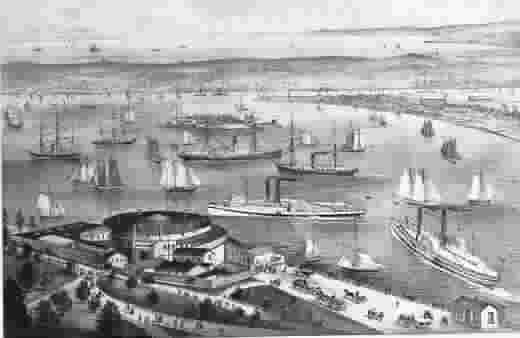| 150 Years in Brooklyn: Arrival in New York Harbor |
||
| Home Immigration Life in Brooklyn Assimilation Research |
Castle Garden and the port of New York, mid 1800s Early Arrivals Before 1855, immigrants were not processed through a central area in New York. Custom collectors worked at the docks and by 1819 were keeping statistics on the numbers of passengers, names, and ports of origins. A state commission in 1847 found that many frauds were being perpetrated against the new arrivals. Boardinghouses hired runners to steer immigrants to their establishments stealing luggage or children in order to get victims to follow them. The boarding houses and confidence men overcharged the immigrants for tickets, rent, and other necessities. By 1848, the state had leased a pier at the end of hubert street to process and protect immigrants but was forced to move to Castle Clinton due to neighbors complaints. Castle Garden Castle Clinton, a circular red sandstone fort built in 1807 on what was then an offshore spit of rocks. Countless fills by the land-hungry city have left it a few hundred feet inland. The fort's history took another turn in 1855, when Castle Clinton became the country's main immigration center Castle Garden. Until Ellis Island replaced it in 1892, more than 7 million immigrants passed through here, mostly Irish, Jewish, and Italian. A few years later it reopened as the City Aquarium, which it remained until 1942. After missing a date with the wrecking ball in the '40s, the Castle became a national monument. Castle Garden provided a standardized way to process immigrants and sheltered them from swindlers. After registration, immigrants could purchase train or boat tickets from approved agents. The procedures developed were eventually used as the models for all immigrant examining stations. Nevertheless, corruption still was present among the staff and outsiders. This eventually led to public outcry and demand for a new solution. Ellis Island
Following the federal takeover of immigration in 1890, the congress appropriated money to convert abandoned Fort Gibson on Ellis Island into an immigration center. Castle Garden had become too small for the traffic of the 1880s. Because of an economic depression during the 1890s, immigration was "light" at 200,000 persons/year. In 1897, fire broke out and the original building was destroyed. In 1898, construction of the present building was started and by 1900 the new building designed to handle 200,000 people.year was complete. By the time it opened however, immigration through New York had reached 500,000 and by 1907 immigration surpassed 1 million.
Italian Mother and her Children arriving at Ellis Island about 1910 Arrival and processing Incoming ships did not stop at Ellis Island or the Statue of Liberty but continued past to piers in the Hudson River. First and second class passengers were processed on board but steerage passengers collected their belongings and boarded small ferries owned by the steamship companies for processing at Ellis Island.
The Registry Room in the main building of Ellis Island circa 1905. Immigrants are grouped and tagged awaiting questioning Immigrants were asked how much money they had with them and my ancestors rarely had more than $10. At one point some Americans tried to require $25 but it never stuck. Nevertheless word of the $25 requirement got back to Europe and later immigrants often arrived with that amount just in case. The examination process that followed was both direct and clandestine. Doctors watched for signs of mental or physical illnesses they walked up ramps into the facility.Inside, following a quick medical examination, they would wait in the registry room for their interrogation.
Immigrant being questioned Meeting Sponsors Once cleared by inspectors, the immigrants were free to get on a train for the trip further west, or to go to New York or New Jersey directly. Depending on the final destination and age or sex of the immigrant, sponsors were contacted to pick up their relatives. Those detained were housed in the main building on wire bunkbeds that filled the lower level. One young relative of mine was detained for a day until his sponsor in Brooklyn could pick him up. It was duly noted that he ate dinner and breakfast, served free in the dining hall, before being picked up at 11am the next morning. Menu 1906(from a letter to the Ellis Island Commissioner Williams)
Sponsors arrived on the Ellis Island Ferry which was abandoned in the slip after the island closed. Before it sank, my grandfather recovered one of the signs on the front and donated it to the immigration museum then housed in the base of the Statue of Liberty. It now hangs in the Ellis Island Museum.
Waiting for the Ellis Island Ferry Destinations The official need for a sponsor, and the natural desire to live around people that you know, prompted immigrants to congregate according to ethnicity and hometown. The O'Neills most likely moved to the Irish community in Brooklyn or the Lower East Side of Manhattan, also known as Five Points. They also lived for several years in the Bergen County, N.J. town of Bergenfield, known as New Bridge at the time, before permanently settling in Brooklyn in the late 1870s. The Gills arriving in the late 1800s and moved directly to Brooklyn upon arrival. While the Pomaricos headed to relatives in Gowanus in Brooklyn, most people from their hometown, Sant Angelo dei Lombardi and the neighboring town of Torella Lombardi moved to the Italian community of Waterbury, Connecticut. The Blumettis and Soggas initially settled in Arberesh communities in Elizabeth, N.J., Jersey City, N.J. and the Lower East Side of Manhattan. Their move to Brooklyn was prompted by slum clearance projects of the 1930s. The Kloseks moved to the West Side of Manhattan until they too were cleared out by the construction of the Lincoln Tunnel which razed their tenement block. |
![]()





